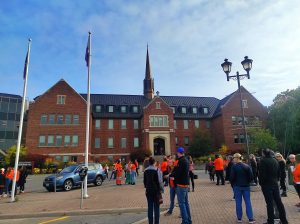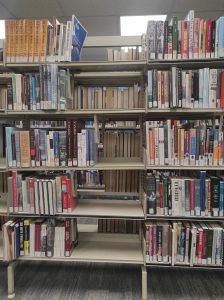A Northern Ontario small town, late fall 2023
After my meeting with AB at her office, I had settled in a coffee shop nearby to finish my notes on our conversation. It was lunchtime and the place was quite packed, being the only downtown location of this popular and cheap coffee-and-donuts chain. The staff was busy pacing back and forth, trying to keep the queue of people by the counter and the one of cars outside on the drive-through lane flowing as smooth as possible. Eastern-European geopolitics was the topic of discussion among the elderly men sitting at the table across the aisle. From the window I could see the parking lot, cars passing through, and a newly constructed city square that, based on what I had heard, divided opinions among locals as to whether it was a welcome effort to make the downtown urban space livelier and safer or a waste of money that could have been used for something else, such as tackling the issues of addiction and homelessness in the city. I turned back to my notes, marked a couple of things I might still have to double-check with A to make sure I had got them right, closed my notebook and stuffed it in my backpack.
As on many other afternoons, I headed to the public library a few blocks away, debating if I should use the few hours before closing time for going through the bunch of scans of old newspaper clips covering a crisis regarding provincial child welfare funding in the late 1970s or continue reading a recent book discussing politics of reconciliation in Canada. On the way I tried to call BC, a family service worker in another community to ask about potential timing for a meeting that we had been talking about earlier. No response – I left a voicemail, knowing that they must be busy. Once arriving at the library, I had a quick call in the hallway with my husband back home seven time zones away before heading in. At the entrance, the heart-shaped ‘Every Child Matters’ installation from the National Day for Truth and Reconciliation was long gone and another one of wartime photos and letters had been set up for the upcoming Remembrance Day.
The above passage has been edited based on a few separate excerpts from my field notes, with some more descriptive details added to provide a typical snapshot of my ‘everyday life’ in the field.
While writing this text, I am approaching the end of the second one of my two fieldwork trips to Canada and have earlier this year passed the half-way post of my part of this project (funding).
The original idea behind returning to the field for a few more months after the initial eight that I spent here last year was both to help maintain relations formed during that first period, and to be able to revisit the field with ideally a clearer picture of what exactly to focus on and what I would still need to learn more about.
However, while setting the focus as indeed felt smoother this time, I also feel that the more I spend time in the field the more aware I become of how much more there would still be to learn and understand of both my research context and topic. At this strange and somewhat chaotic stage of simultaneously still being in the field, working on the analysis and getting started with writing, there are (often!) days when I feel that I am only now starting to have gained a comprehensive picture enough of ‘the field’ to be able to start drafting a research proposal. It is a very valid question how big part of this is about normal characteristics of ethnographic research versus a result of having chosen a topic that matches uneasily with the combination of my positionality and the methodological traditions of my discipline.
My research, to put it very broadly, concerns realities of and aspirations for systemic changes in child and family services for First Nation families in Ontario, Canada. This topic situates in the contexts of continuing legacies of earlier settler state policies and practices of removing Indigenous children from their families, communities and culture, and of the current political era where reconciliation has been declared as the guiding principle to be pursued in relations of the government and other settler institutions with Indigenous peoples. My focus has been particularly on perspectives of those working on these changes regarding child and family services ‘on the ground’; either through their own First Nation, an Indigenous or non-Indigenous child welfare agency or another family service provider.
Myself, I am a non-Indigenous scholar coming from another country, with no experience of child welfare system neither in personal nor professional sense. This setting very obviously entails certain limits as to what kind of social spaces and knowledge are accessible to me as a researcher, and the need to remain aware of those limits in the field to approach the topic in a respectful and non-intrusive way. That is, this topic is not really one about which a person of my background would be in a position to draw interpretations based on observation of everyday life of a community it concerns, unless building such study on an existing strong and confidential relationship. In addition to awareness of the limits my positionality sets for approaching this topic while in the field, it requires staying mindful about the inevitable limits of my knowledge and perspective when writing about it.
A great deal of this fieldwork – now talking about my fieldwork experience as a whole and not only this ongoing trip – has been about learning. I have had the honour to get connected with several people with extensive experience of the work towards just and culturally grounded services for First Nation children and families in their respective communities. These people have, by sharing their experiences and knowledge, helped me to deepen my learning about the broader historical and local contexts of Indigenous child welfare and to adjust my focus accordingly. Another aspect of this learning has also been looking at the ideas and structures that the child welfare system as it exists today has been built on, and how these have changed over time: from familiarizing with provincial child welfare legislation and discussing it with people working under it to hours spent in several different archives looking at various kinds of policy documents, reports and proposals from the decades past.
Spaces and moments of this learning process have been diverse, extending from face-to-face encounters to archival documents to online sources. While conducting fieldwork in a specific area in North-Eastern Ontario where I have purposefully spent longer stretches of time within the past year-and-a-half, this fieldwork has still been of rather sporadic nature instead of full-time immersion into everyday life of a specific community. That is, my explicit engagement with the topic through interviews, discussions or participant observation has been limited to specific occasions, such as meetings with child and family service providers and visits to relevant public events.

I thus find that the concept of ‘patchwork ethnography’ introduced by Günel, Varma and Watanabe describes my engagement with the ‘field’ better than the idea of linear, long-term fieldwork. Instead of detailed documentation of first-hand experience of day-to-day life in a particular fieldwork context, my research has rather turned out to draw from bits and pieces from a bunch of different sources from encounters and discussions in the field to archival documents and news content.
However, this is not to say that the overall experience of spending long stretches of time in the fieldwork area would have been useless; while most of the ‘everyday encounters’ in the field have not necessarily touched directly upon the research topic, many of them have helped me to make sense of its broader local, historical, political and socioeconomic contexts. This is why what I have found relevant moments in the field also include things such as walks in the town paying attention to presences and absences of references to the Indigenous history of the area; getting shocked by prices of groceries or housing; eyeing through microfilms of old newspapers at the local library; or listening to locals of different backgrounds and generations talk about the history or demographics of the area, or social divisions in the city while they were growing up.

This ‘patchwork’ of mine does not by any means make up an in-depth study of understandings and awareness of colonial history in this particular location. However, what I nevertheless hope it can give to study of (settler colonial) institutions and expectations and challenges in changing them is to suggest an approach that pays attention to particular local contexts where institutions such as child welfare operate.
